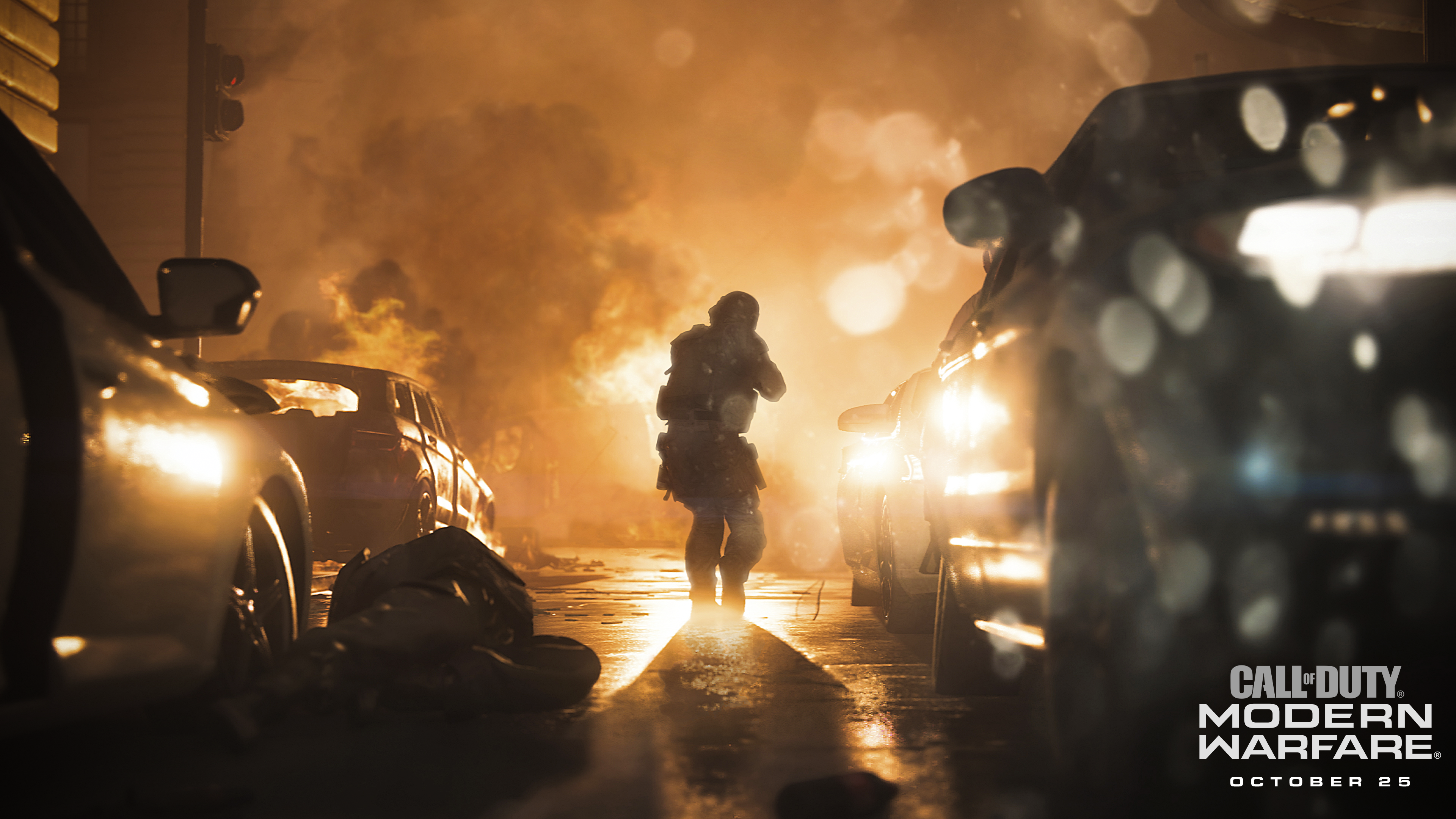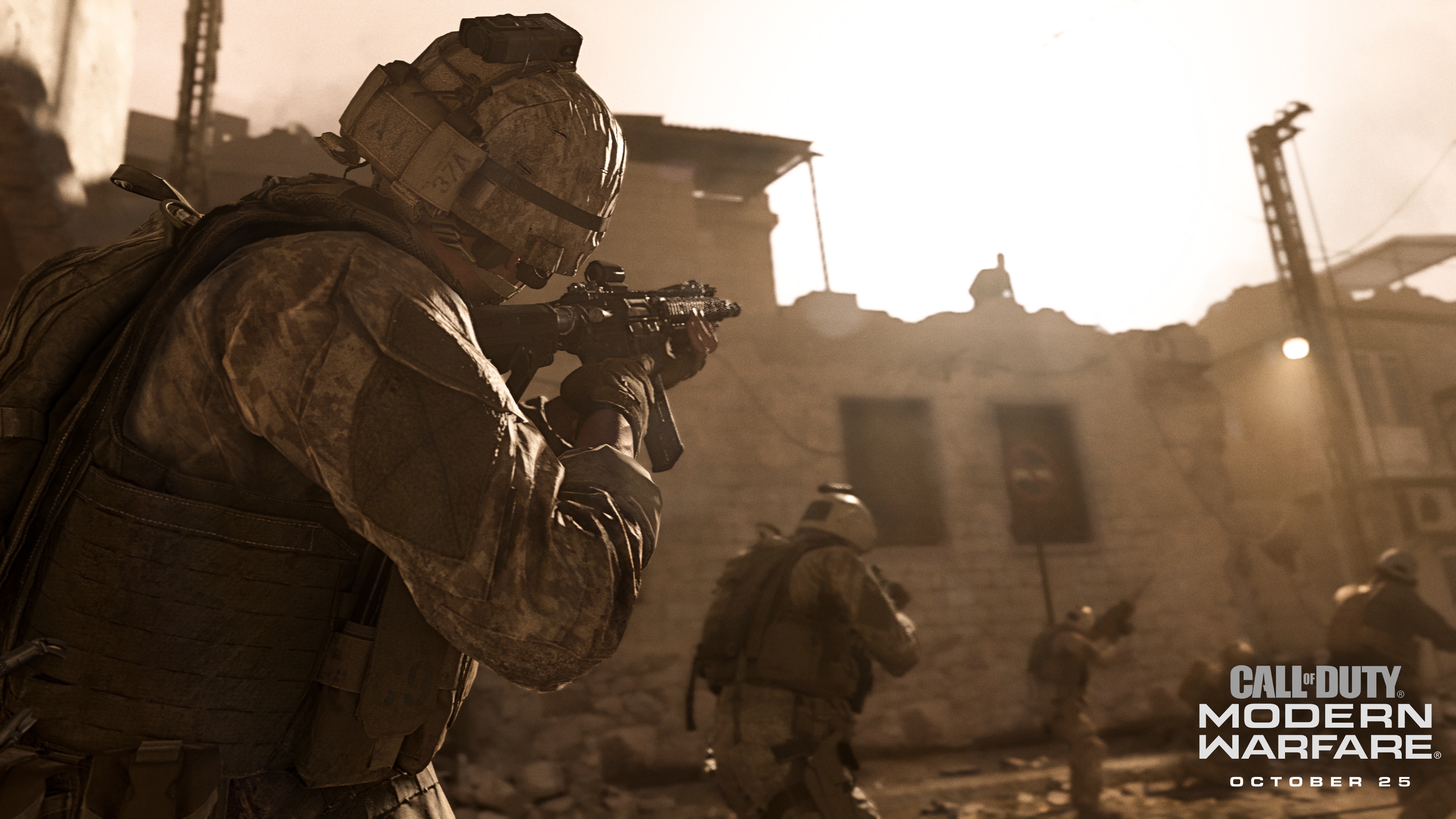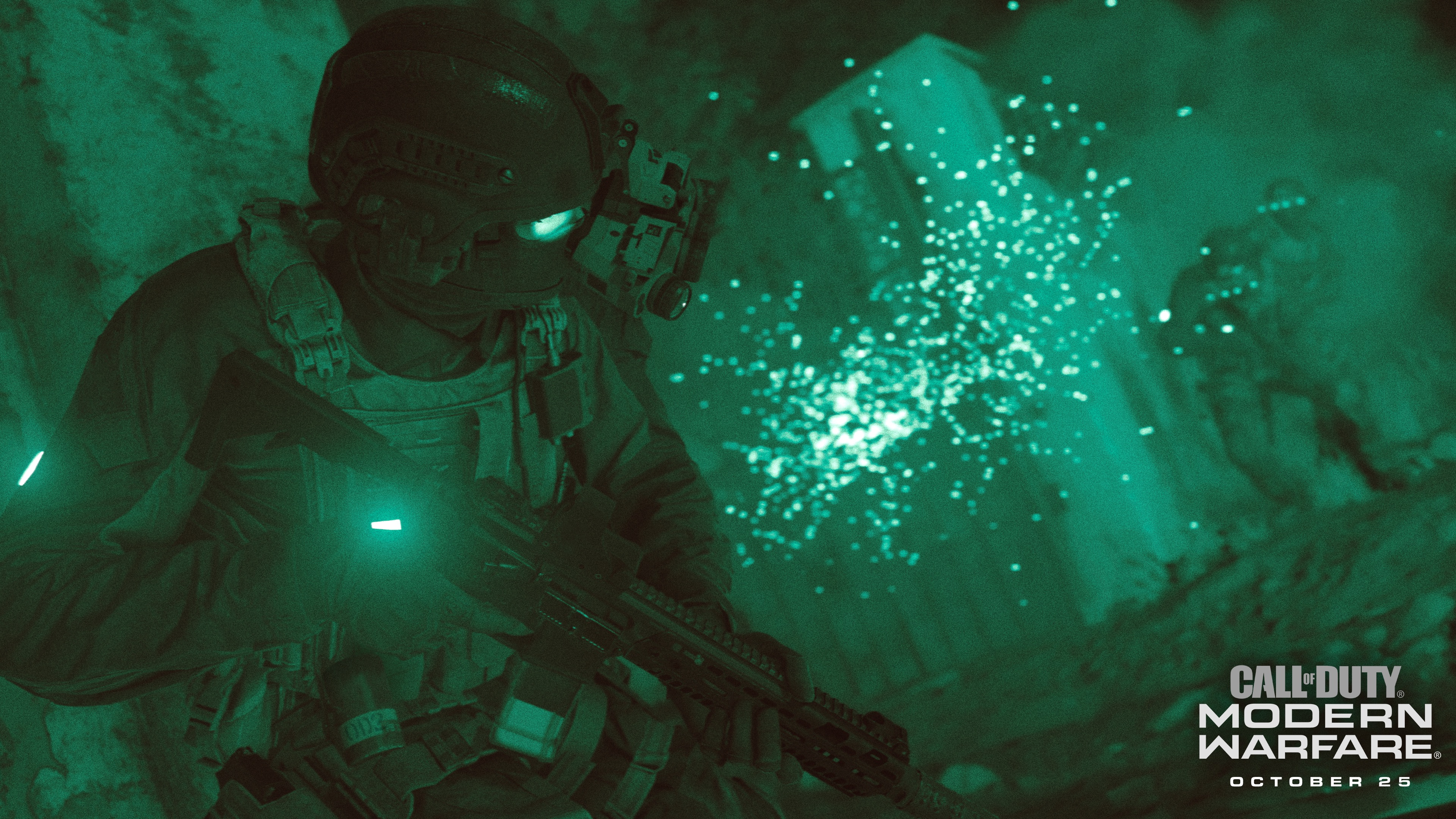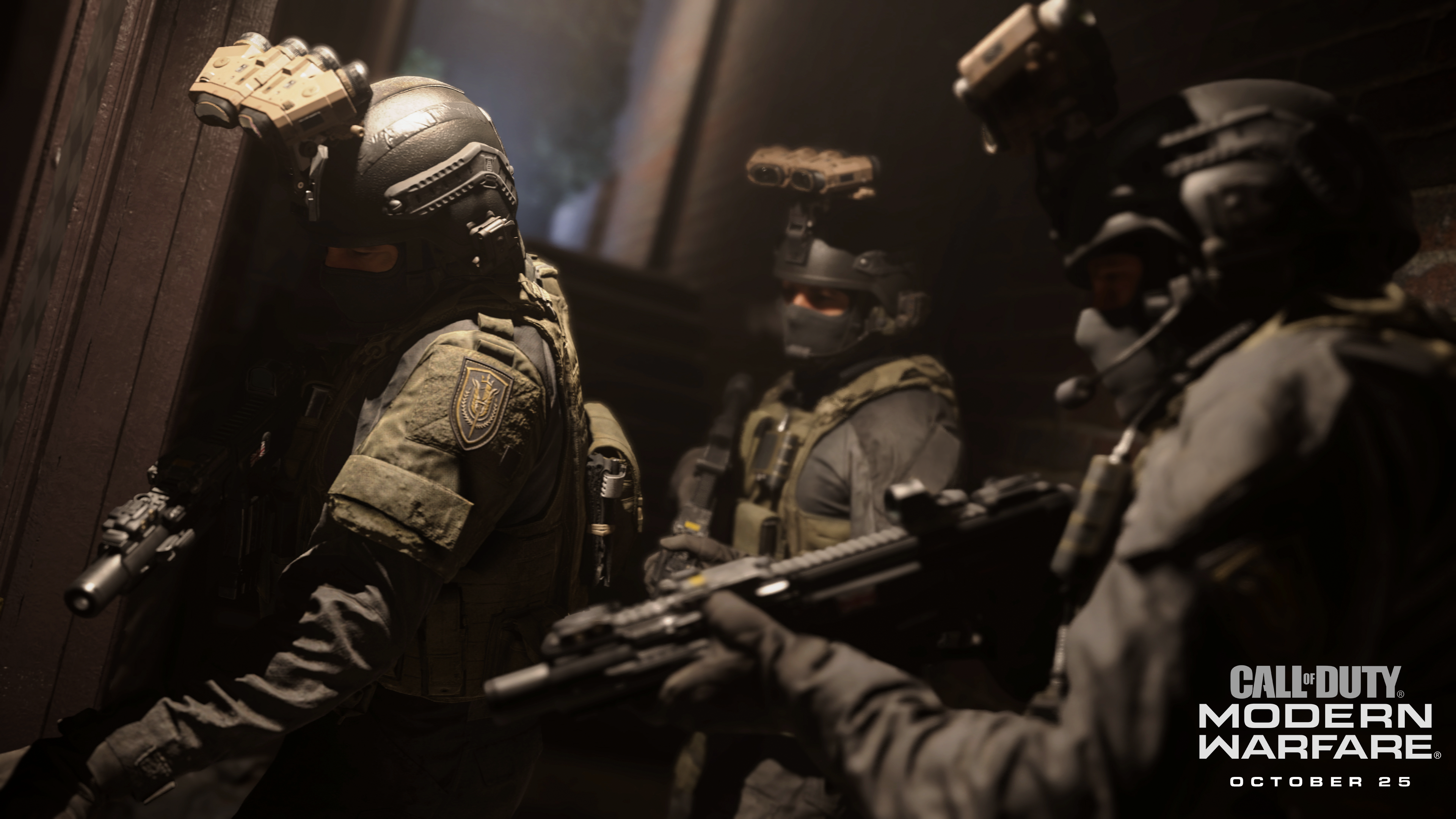Call of Duty: Modern Warfare has a crisis of identity.
This was the clearest takeaway I could find while sitting in a dark theater after a long presentation about Infinity Ward’s reboot of the FPS franchise, which is due this October 25 on PS4, Xbox One, and PC, and which I got to see during a press event earlier this month.
Over the preceding hour, members of the development team beamed with pride and spoke with enthusiasm as they described the game they’d spent the last few years making. The only problem is that it sounded like the group was talking about two different games.
Which left me with questions: Is this new Modern Warfare aiming to be an intense exploration of the complexity of war, or does it instead want to celebrate the technologies, tactics, and violence of combat? Does the development team hope to make players feel uncomfortable with the power they have at their disposal, or should we luxuriate in their capacity for destruction (rendered in higher audio-visual fidelity than ever before)?
Above: Call of Duty: Modern Warfare reveal trailer.
Maybe there’s a version of this pitch that blends the two well. Maybe instead of describing the violence as “visceral” and leaving it there, you wrap back around to your narrative and thematic aims, and tie the two together. Maybe you spin out some bullet points about how the echo of gun fire helps to produce a sense of vulnerability for players. But that isn’t the pitch I saw. Instead, I got a look at one game that may as well be two.
The first pitch came from Jacob Minkoff (Campaign Gameplay Director) and Taylor Kurosaki (Studio Narrative Director), both of whom spent time at Naughty Dog, developers of The Last of Us and the Uncharted series. It’s a pedigree that, we’re told, makes them perfect for rebooting Modern Warfare with a greater focus on story than ever before. They were bringing a new vision to the series, one that captured the best elements of past series entries while also introducing a fresh perspective never seen in a Modern Warfare game before.
Here’s their pitch in brief and in as close to their own words as I can provide, without my own editorializing: Yes, Modern Warfare is an action game, but in contrast to the superheroics of other Call of Duty titles, it will have a focus on “authentic and gritty” military action. It’s also an action game that will draw from “relevant headline situations” and will include “social commentary,” which “has always been part of Modern Warfare’s DNA,” gesturing to past, headline-grabbing levels like “No Russian.”

What sort of social commentary? Well, war, they say, is “more complex than it was 10 years ago.” It’s “no longer only over there, it’s global,” and “it isn’t black and white. It’s morally gray.” Enemies “rarely wear uniforms,” and violence on all sides causes “terrible collateral damage.” In this “tough to navigate world,” “one man’s freedom fighter is another’s terrorist.” Which is why, for the first time, players will take the role not only of Tier 1 special forces operators, but also “rebels” in an (unnamed) Middle Eastern nation who fight both occupying terrorist forces and “military-industrial” invaders.
And under all of it: Characters. People we could care about. Whether they were returning favorites like SAS soldier Captain Price or new ones, like rebel commander Farah Karim, “characters are the stars” of Modern Warfare.
As a sprawl of bullet points and marketing phrases, it wasn’t a very effective pitch. The team’s ambition was clear, but their sell seemed confused and contradictory, perhaps most importantly around the idea that “war has changed.” Certainly, mainstream American perspectives on war have changed since the start of the forever war—a term that has now been in use for over a decade, describing the interminable “war on terror” that has left American military forces deployed in Iraq and elsewhere in the Middle East for so long that next year, people born before this war began will be able to vote for president. Which is to say that we call it the forever war for a reason, and a change in opinion is not a change in the realities of war, especially for those living “over there.”
Thankfully, Infinity Ward didn’t only have a slideshow presentation.

After their long preamble, the game’s narrative leads introduced the first gameplay for us. In the aftermath of a terrorist bombing, a British SAS team, prepared to storm a four story residential building housing a terrorist cell. In green-and-white night vision, the player moved towards the building, latched a grappling hook to the roof, and climbed up to a second-story window, quietly entered, and moved towards a closed door. Behind it, a man and a woman were debating something with fear in their voices. Before they could agree, the theater took in a collective breath, and the special ops team breached the room, not with perfect precision, but with an uncomfortable mix of confusion and power.
I’ve seen dozens of levels just like this. Hundreds, maybe. But I’ve never seen a game lean so strongly into the ambiguity of this sort of police or military action. It’s not only that you don’t know what’s behind a given door, it’s that the people behind those doors actually read, visually, as human. Partly, that’s to do with the blurriness of night vision, but it’s also because of a focus on animation, character design and fashion, and voice work. When one character offered to surrender, only to be gunned down by a player already mid motion, the whole room emotionally deflated.
With each floor of the townhouse cleared, the violence felt increasingly uncomfortable. There was a clear investment in making every trigger pull feel bad, and that was explicitly by design. The team linked the level to the original Modern Warfare’s “Death from Above,” which put the player in the safety of an AC-130 Gunship and recreated then-recent viral video footage of what asymmetrical warfare looked like. It was a level that, the narrative leads of the new Modern Warfare say, made them reconsider what they thought they understood about violence generally, warfare specifically, and the ways technology interacts with both. They hoped that levels like this one would do the same for players this fall.

It wasn’t perfect—there’s a moment that uses a baby in a low-hanging fruit way to ratchet up tension, and the final moments reassure the player that pulling the trigger all those times was absolutely necessary. But in that level, I could see the game beyond the fact sheets and the slideshow and the carefully designed taglines. The messiness of the pitch fell away, inconsistencies felt more forgivable. I was ready and eager to see what else this team would do.
Unfortunately, each segment of the presentation that followed only muddied this high.
In a follow up gameplay section, we saw gameplay from the perspective of a young Farah, the girl who would eventually grow up to be the commander of the rebel forces at the center of the game’s story. Having lost her mother in an explosion, Farah is dug out from rubble by her father, but before they can finish speaking, a missile strikes down the road, sending sand and dust into the air in a way comparable to the earlier London bombing we saw.
Fleeing from an invading Russian army, Farah and her family are eventually cornered by a soldier who kills her father and who, in an extremely gamey sequence, Farah and her brother must take down in what amounted to a stealth boss fight. The player needs to evade capture, crawling through vents in the walls, and locate a screwdriver to use as a weapon on the soldier. After doing this three times—again, it really reads like a boss fight—they kill their pursuer in a flurry of stabs tuned to surprise you, but which mostly read as a tryhard play for shock value.

This is all followed by a forced stealth sequence that could’ve been ripped from any other FPS in the last month, and it was just all so flat, especially in comparison to the earlier townhouse level. That earlier originality (and again, the investment and prioritization on thematic effect) drew into sharp relief the reliance on tired cliche in this follow up footage.
This is doubly frustrating, since it was my only look at “rebel freedom fighter” gameplay, and there is a real opportunity to shake up this genre by shifting the perspective. While many war-focused FPS games are eager to highlight “the horrors of war” in the abstract, very few take critical positions on particular military ventures, least of all America’s own. A game that genuinely attempts to capture the viewpoint of the very real people impacted by the unbridled militarism of the world’s most powerful nations would at least potentially be able to say something new.
(Of course, we were told during this presentation that the rebel faction will be fighting invading Russians and an occupying terrorist force alongside Captain Price and the SAS. So, my expectations that we’ll see such a paradigm shift here are muted.)
Then, the presentation took an even further turn, as members of the team’s technology and art teams took to guiding us through the many new features, technologies, and techniques at play in the new Modern Warfare.
...it felt dissonant and detached.
We were walked special new photogrammetry process that makes burned out car doors look more real, and we were shown cutting edge materials tech that made the layered fabric of the ghillie suits really pop. For 10 minutes, we watched and listened as the audio director showed off the way guns echo differently depending on environment and positioning thanks to new raytracing technology. Listen, we were asked, as the bullet shells being flung from the submachine gun’s chamber bounce off the side of this bus. Feel the concussive blast of an explosion as a grenade goes off in front of you. Look at these guns, floating in the air, details on display. Look at these guns sway with your body. Look at these guns as you reload them even when aiming-down-sights! Look at these guns.
After that earlier, narrative focused sell, Animation Director Mark Grigsby (back to Infinity Ward after going to Respawn to work on Titanfall 2), stood in front of the theater and told us that his team followed this mantra: “The weapons are the stars, and the player must feel like a badass when they wield them.”
And look. I’m not dragging Grigsby here. I suspect that he was told that was his job, and frankly, each member of the tech and art team presented demonstrations that spoke to the quality of their work and the creativity exhibited. In a vacuum—or even separated, presented on its own—this runthrough of the tech behind Modern Warfare would have been incredibly impressive. But in this context, where just thirty minutes prior, we’d been pitched on a game that was a critical take on warfare, one that would focus first and foremost on characters and big picture ideas, it felt dissonant and detached.

Worse, it shook away any illusion that the townhouse level would be experienced, en masse, the way it was for us in this theater. We had been primed by the developers, told their intent, led into the level by the hand by people who wanted us to see what they were going for. But this October, players are going to need to do that thematic lifting for themselves. Or, as is the era we live in, they’ll be guided by streamers, many of whom will have little interest in the ambiguity of warfare, but who will absolutely see the guns as the stars and feel like a badass as they wield them.
The failure to reconcile these two pitches is immense, and it gets more complicated when you add in competitive multiplayer and co-op play, both of which were announced today but neither of which can I speak to. At the heart of this disconnect is a real, meaningful tension: Infinity Ward needs to sell a game to an audience that wants to feel powerful. But they also want to do more than make yet another celebratory war procedural, instead offering something that explores and critiques (however slightly) the culture that has made the forever war possible.
I’m sympathetic to this split, and to anyone trying to squeeze liquid, artistic innovation from the dry stone structure that AAA game development and marketing demands. But sympathy isn’t faith. Which is to say, coming out of that event, all I can be confident of is that bombed out battlefields and the air-borne detritus of domestic attacks will look more realistic than ever before, and that when you pull the trigger, you’ll feel badass.
Modern Warfare is out on October 25th. Maybe between then and now, publisher Activision will decide which game they want to sell us.
Have thoughts? Swing by the Waypoint forums to share them!
from VICE http://bit.ly/2HMADiu
via cheap web hosting
No comments:
Post a Comment